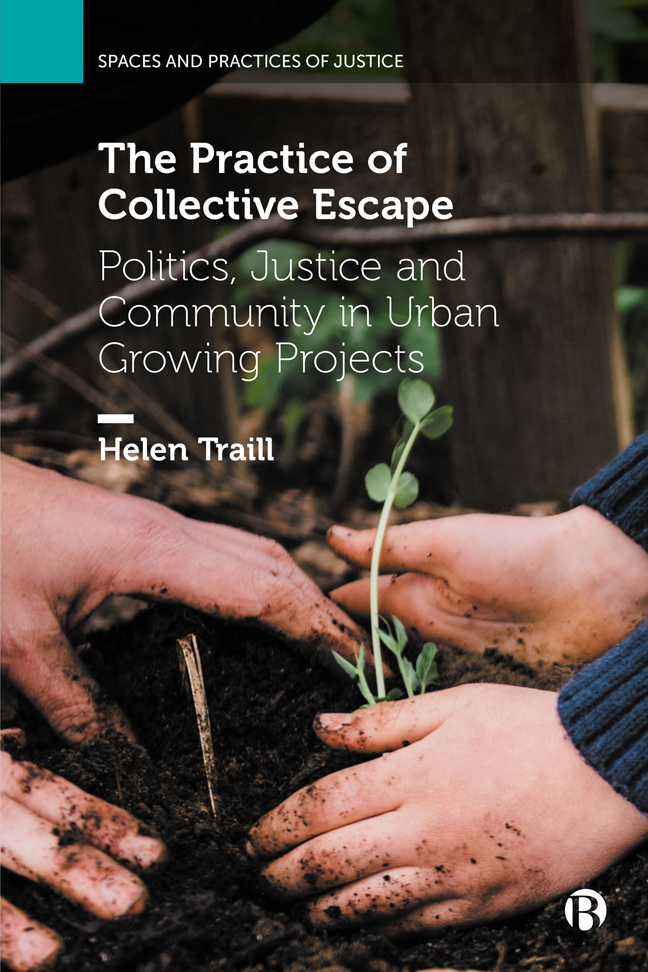Book contents
- Frontmatter
- Dedication
- Contents
- Series Preface
- Acknowledgements
- 1 Introduction
- 2 Urban Growing in Glasgow
- 3 The Rhythms of Urban Escape
- 4 Who Gets to Escape?
- 5 Ownership, Autonomy and the Commons
- 6 Escape into Responsibility
- 7 Field Dynamics and Strategic Neutrality
- 8 The Political Imagination of Common Justice
- 9 Escape, Crisis and Social Change
- 10 Conclusion
- Notes
- References
- Index
3 - The Rhythms of Urban Escape
Published online by Cambridge University Press: 23 January 2024
- Frontmatter
- Dedication
- Contents
- Series Preface
- Acknowledgements
- 1 Introduction
- 2 Urban Growing in Glasgow
- 3 The Rhythms of Urban Escape
- 4 Who Gets to Escape?
- 5 Ownership, Autonomy and the Commons
- 6 Escape into Responsibility
- 7 Field Dynamics and Strategic Neutrality
- 8 The Political Imagination of Common Justice
- 9 Escape, Crisis and Social Change
- 10 Conclusion
- Notes
- References
- Index
Summary
‘A depressurizing chamber’
In the mornings, on the way to school drop off, Natalie and her daughter cut across the meadow. As her daughter gets older, Natalie finds the encouragement onto the site can get rid of a certain funk associated with the morning drudge. No matter how stressed everyone is – getting lunches together, has the homework been done, where are the shoes – the space of the meadow provides what Natalie calls a “depressurizing chamber”. It allows for the evaporation of the pressures of getting to school or work, and creates a brief period of quiet, green, social time in an otherwise hurried day. The idea of seeing the dogs and their owners acts too as an incentive to Natalie's daughter to get out the door. Natalie, laughing, admits to me as we talk in the woods that this works on her too. In this way, the meadow provides an important escape, however temporary and mundane, from the pressures of everyday life.
Both projects create time and space for alternative ways of living the city, opening up the possibility of alternative urban rhythms. In attempting to move beyond the pressures of everyday life, the case studies carve out spaces of autonomy and solidarity in the city. I characterize such action as escapist, although the experiences within each space vary between projects and participants, shaping how each place is understood. There are differences between the sites around how structured the rhythms are; but there are also many similarities, especially around reconnection with others and the natural world. In this, escape is a multiplicitous lens for considering communal growing projects.
Rhythm as a heuristic
Natalie's account highlights the everyday rhythms of the space; how the intersection of her school run with the lives of dog walkers creates a social moment in the mornings. In exploring how escape is lived, I draw on the work of Lefebvre, which provides a theoretical grounding for understanding the texture of escape within communal growing. Lefebvre (2004) noted that rhythm was everywhere, constructed at every juncture where place, time and action combine. An understanding of rhythm, he expected, would deepen our understanding of urban life and its various characteristics and structurings, extending his work on the production of space (Lefebvre, 1991, 1996). What rhythm offers is a way to think time and space together (see also Massey, 1994).
- Type
- Chapter
- Information
- The Practice of Collective EscapePolitics, Justice and Community in Urban Growing Projects, pp. 31 - 48Publisher: Bristol University PressPrint publication year: 2023



